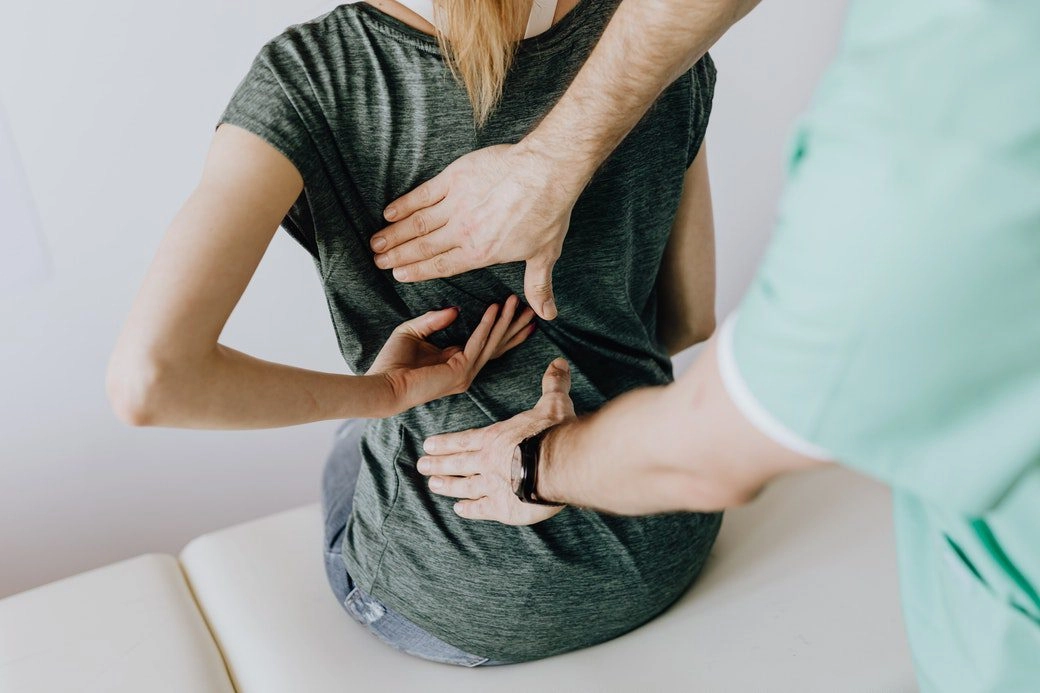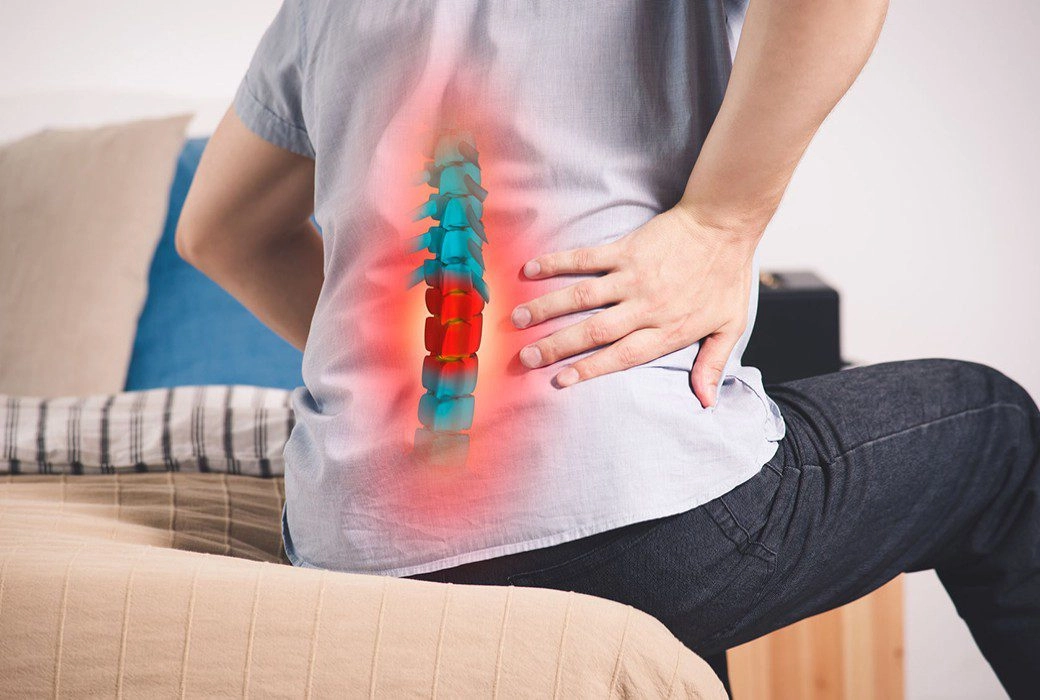Herniated discs and lumbar sprains are two of the most common back problems afflicting people today. And they’re not often easy to tell apart. But there are ways you can tell if it is a lumbar sprain or a herniated disc.
Back sprains are usually relegated to the back area, meaning they don’t cause pain elsewhere in the body. The pain also tends to lessen when bending forward and return when straightening from a forward bend. Herniated discs usually cause pain down the leg, and tend to hurt with any back movement.
That said, it’s possible for a back sprain to hurt with any back movement as well. It’s simply not as common. Herniated discs don’t always cause pain, either. Luckily there are other ways to tell if you sprained your back or if you have a herniated disc. Read on to discover how.
What’s The Difference Between a Herniated Disc and a Lumbar Sprain?
The main difference between a herniated disc and a lumbar sprain is the part of the body that’s hurt. A sprain affects the ligaments between two bones, otherwise known as a joint. A joint is held together with fibrous, tough tissue that can become damaged or torn.
A herniated disc, on the other hand, happens to the discs between the vertebrae, otherwise known as spinal joints. The spinal discs are essentially cushions between vertebrae. When one becomes injured, it bulges out and can press on a nerve along the spine, causing pain in the back and other areas.
Herniated discs can heal on their own without surgery, but they often require some form of conservative treatment. Sprains and strains can benefit from conservative treatment, but can often be addressed at home easily.
Back Sprain vs Back Strain
When we’re talking about a sprain or a strain, we’re technically talking about two different things. These terms are often used interchangeably, but there is a difference. A sprain affects the ligaments between bones, whereas a strain affects the muscles or tendons that secure muscles to bones.
Herniated Disc Symptoms
To know the difference between a herniated disc and a back strain or sprain, it’s important to know the symptoms of each. Herniated discs come with common symptoms such as:
- Pain down one leg.
- Pain down the arms (in the event of a herniated disc in the upper spine).
- Pain with certain movements, such as bending down, standing up, or sitting.
- Pain that gets worse at night.
- Weakness in the back or affected leg.
- Tingling, numbness, or a burning feeling.
The long-term effects of a herniated disc vary widely. If left untreated, some may require surgery while others will not. This is why it’s best to get professional help if you suspect you have a herniated disc.
Herniated Disc Tests
The best way to diagnose a herniated disc is with the help of a medical professional. You can pay attention to the symptoms above and get a good idea of whether you have a herniated disc, but a physician or chiropractor can help identify the issue properly. You can expect a number of tests and questions to diagnose a herniated disc. These include:
1) Reflex Tests
- Many people with lumbar disc herniations have dulled reflexes related to the patellar tendon. The doctor may tap just below the kneecap with a rubber hammer to see how the reflexes are working. If they are dulled, it’s often a sign of a herniated disc.
2) Range of Motion
- You may be asked to lean forward or back, bend over, sit, stand, and or walk around in certain ways. The medical professional will often ask you when you feel pain because pain during certain movements also indicates a herniated disc.
3) LaSegue Test
- Also known as the leg raise test, you may be asked to lay flat on your back while the doctor or chiropractor raises your straight leg until you feel pain. Where your leg is during this test is a good indication of the cause of your pain.
4) Imaging Tests
- If the physical tests don’t show conclusive results, some medical professionals may want to take imaging tests such as an MRI, X-Ray, EG, or CT scan. However, this depends on the severity of your pain and other factors determined by the doctor.
Lumbar Sprain Symptoms
Lumbar sprains and strains present similar symptoms. These often include:
- Pain and stiffness in the lower back and as low as the buttocks, but not the legs.
- Limited range of motion due to stiffness and pain.
- Muscle spasms in the affected area.
- Pain tends to lessen when bending forward.
Sprains or strains are usually the result of typical movements such as standing up, stretching, sitting down, picking something up, or reaching for something. They also tend to respond well in the short term to ice and anti-inflammatory medicine.
Lumbar Sprain Tests
Many of the tests for lumbar sprains are similar to those for disc herniation. How you respond to the tests will tell the physician or doctor of chiropractic whether you have a herniation or a sprain.
The most common sprain tests are those that involve range of motion and reflexes. Sometimes a medical professional can even diagnose a sprain or strain on your symptoms alone.

Herniated Disc Treatment
Most common disc herniations don’t require surgery to correct. However, this depends on the cause of the herniation, the severity, and your overall health and lifestyle. Healing naturally is usually the best option, so conservative treatments should be exhausted before surgery is considered.
The first course of action for herniated discs is to get the pain under control. There are several treatment options available to do this:
- Ice therapy to reduce pain and swelling.
- Non-steroidal anti-inflammatory drugs (NSAIDs).
- Muscle relaxants and painkillers for spasms and severe pain.
- Limited rest (usually no more than 2 days).
- Heat therapy (typically only used after the first 2 days and once the swelling is down).
- Steroid injections.
Once the pain is under control and the swelling is down, other treatment options can focus on addressing the herniation itself. These treatments include:
- Chiropractic adjustments
- Chiropractors can help heal herniated discs effectively in a number of ways. The most common include spinal adjustments to take the pressure off the disc and correct the underlying issues.
- Physical Therapy
- Often used in conjunction with chiropractic care, physical therapy can help return strength and improve the range of motion in the back. This is the reason why Better Health Alaska offers physical therapy along with chiropractic and massage therapy for a holistic treatment.
- Acupuncture
- Massage Therapy
Herniated Disc How Long to Heal
Herniated discs vary widely in how long they take to heal. In most cases, they heal within 6 to 8 weeks. When conservative treatments are employed, such as chiropractic care, some patients see relief in as little as a few days or a week. Your overall health and your ability to follow treatment protocols will also affect the healing process.
The worst thing you can do for a herniated disc gets too much bed rest. It may seem counterintuitive, but the back muscles and the spine need to be used gently to facilitate healing and help prevent future injuries.
Back Sprain Treatment
Although severe back sprains and strains can be incredibly painful, the need for surgery or anything other than conservative treatments is rare. Nearly 90% of back sprain and strain injuries heal fully without surgery. Some treatment options include:
- Ice therapy for the first 48 hours.
- Limited rest (usually no more than 3 days).
- Non-steroidal anti-inflammatory drugs (NSAIDs).
- Muscle relaxants and painkillers (for severe cases).
- Different chiropractic adjustments and/or massage therapy.
Lumbar Sprain How Long to Heal?
How quickly a sprained back heals depends on many factors. Your overall health is perhaps the biggest factor. Poor health will make the healing process slow. If you can’t avoid using your back muscles immediately after the initial injury, you could increase the healing time by weeks or months.
Most lumbar sprains take 3 to 4 weeks to heal. Some can heal in as little as a few days, while others take up to 10 weeks or more. If your sprain hasn’t gotten any better within a week, consider seeing a chiropractor or physician for help.
Lumbar Sprain vs Herniated Disc
Although often confused, a lumbar sprain and a herniated disc present some specific symptoms. With the help of a qualified medical professional, you can determine which you are suffering from.
Luckily most people heal fully from both injuries, and it’s rare that either of them requires surgery. Conservative treatments are the best, safest bet for treatment. Chiropractic care is ideal because it helps to address the underlying cause of the injury, helping you ward off future sprains or herniations.
To learn more about your condition, visit your local physical therapist at Better Health Anchorage in Alaska.
Resources:
https://www.sciencedirect.com/science/article/abs/pii/S1529943005008338
https://www.nejm.org/doi/full/10.1056/nejm199502093320602









